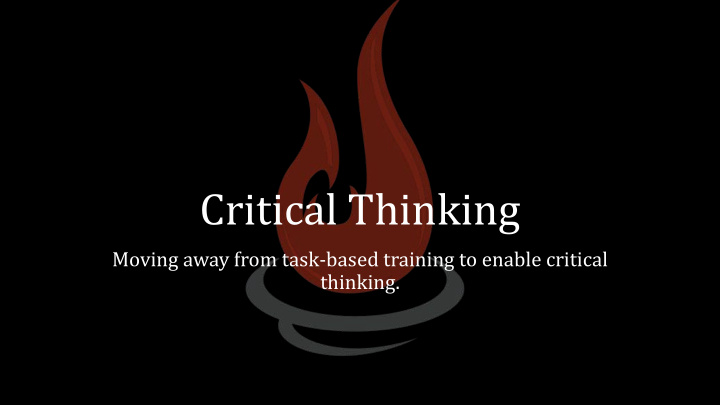



Critical Thinking Moving away from task-based training to enable critical thinking.
Why Are We Here? • What’s in this for you • A new perspective to a subject you already know • Interactive…not a lecture • This is for you • Take-aways you can actually use • Use everyday examples during the discussions
Short intro… • Over 20 years in the oil and gas industry • Started as a process operator in refining • Experience as a contractor, shift manager, and project management • HSE Compliance Training Coordinator for plant of 1800 employees • Director of Operations and Compliance Training for US Fortune 75 oil and gas company • Global organizational and leadership/management consultant • Adjunct professor in Process Technology degree programs • Degree in Psychology, w/focus on Industrial/Organizational Psychology
Oilfield Accident • oilfield.wmv • What went wrong? • How could it have happen? • Were the workers trained?
What is Critical Thinking • Definition • “Critical thinking is the intellectually disciplined process of actively and skillfully conceptualizing, applying, analyzing, synthesizing, and/or evaluating information gathered from, or generated by, observation, experience, reflection, reasoning, or communication, as a guide to belief and action. ” • Source – The Foundation for Critical Thinking www.criticalthinking.org 2015 • What’s the difference in “knowing how to work the process” versus “knowing how the process works”? • Which employee would you rather have? Why?
Why Critical Thinking • Is there a difference between task-based and performance-based training? If so, what is it? • Is it important to know and understand the difference?
Training Approaches • Task-Based or Performance-Based? • What’s the difference? • Instructor-Centered or Learner-Centered? • Is one more important than the other? • “…how to work the process” versus “…how the process works”? • What’s the difference?
Practical Example – Task-based • PASS Fire Extinguisher Operating Steps: • Step 1: PULL the pin • Step 2: AIM the nozzle at the base of the fire • Step 3: SQUEEZE the handle • Step 4: SWEEP from side to side
Practical Example – Critical Thinking • PASS Fire Extinguisher Operation Steps: • Squeeze the handle • Sweep from side to side • Aim the nozzle at the base of the fire • Pull the pin • Arrange in correct order and explain why
Critical Thinking Exercise • Distillation Tower Start-up Procedure Steps: • Start Bottoms flow • Start reboiler heat medium flow • Start feed pump and establish flow • Build reflux drum level • Line-up tower overhead vent gas pressure control • Start reflux to tower • Start cooling water flow to overhead condenser • Start overhead product flow • Build tower bottoms level
Critical Thinking Exercise Answers • Distillation Tower Start-up Procedure Steps: • Step 1: Line-up tower overhead vent gas pressure control • Step 2: Start cooling water flow to overhead condenser • Step 3: Start feed pump and establish feed flow • Step 4: Build tower bottoms level • Step 5: Start reboiler heat medium flow • Step 6: Build reflux drum level • Step 7: Start reflux flow to tower • Step 8: Start bottoms flow • Step 9: Start overhead product flow
What is your current state • How do you train now? • Is it task-based or performance-based? • If you could, would you change anything? What would it be?
Piper Alpha • J - piper alpha long.wmv • Make a list of what went wrong • Don’t leave anything out you notice • Be prepared to discuss what you saw
Process Safety Management • In the early 1990’s, the Occupational Safety and Health Administration (OSHA) developed PSM requirements in response to several catastrophic industry accidents
Process Safety Management (PSM) • PSM is comprised of 14 Elements: 1. Employee Participation 2. Process Safety Information 3. Process Hazard Analysis 4. Operating Procedures 5. Training 6. Contractors 7. Pre-Startup Safety Review 8. Mechanical Integrity 9. Hot Work Permit 10.Management of Change 11.Incident Investigation 12.Emergency Planning and Response 13.Compliance Audits 14.Trade Secrets
Critical Thinking application • How does what you noticed in the video compare to the PSM Elements? • Is it better to lecture on the PSM Elements or show how and why they came to be? • Does it make more sense to have a practical application?
Critical Thinking… • Knowing “How the process works” versus knowing “How to work the process” • Moving beyond “What, when, where, and how” and understanding the “Why” • Pro-active, not just dependent on re-active
Practical Application • Think about a learning effort that could be improved with critical thinking methodology applied to it • Take some time to think about the steps: • Rationale • Objectives • Methods • Evaluation • How would you apply critical thinking?
Summary • What is Critical Thinking • Why is it important • Difference between “How the process works” versus “How to work the process” • Moving beyond the ‘What, How, and When” to the “WHY”
In closing… • What? • What did we discuss? • So What? • Does it matter? • If so, why? • Now What? • What did you takeaway today? • What is your next step/s?
Thank you Ken Jackson 620-262-5089 www.kenjacksonandassociates.com ken@kenjacksonandassociates.com
Recommend
More recommend